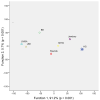Sequencing ancient calcified dental plaque shows changes in oral microbiota with dietary shifts of the Neolithic and Industrial revolutions
- PMID: 23416520
- PMCID: PMC3996550
- DOI: 10.1038/ng.2536
Sequencing ancient calcified dental plaque shows changes in oral microbiota with dietary shifts of the Neolithic and Industrial revolutions
Abstract
The importance of commensal microbes for human health is increasingly recognized, yet the impacts of evolutionary changes in human diet and culture on commensal microbiota remain almost unknown. Two of the greatest dietary shifts in human evolution involved the adoption of carbohydrate-rich Neolithic (farming) diets (beginning ∼10,000 years before the present) and the more recent advent of industrially processed flour and sugar (in ∼1850). Here, we show that calcified dental plaque (dental calculus) on ancient teeth preserves a detailed genetic record throughout this period. Data from 34 early European skeletons indicate that the transition from hunter-gatherer to farming shifted the oral microbial community to a disease-associated configuration. The composition of oral microbiota remained unexpectedly constant between Neolithic and medieval times, after which (the now ubiquitous) cariogenic bacteria became dominant, apparently during the Industrial Revolution. Modern oral microbiotic ecosystems are markedly less diverse than historic populations, which might be contributing to chronic oral (and other) disease in postindustrial lifestyles.
Figures




Comment in
-
'Paralysed by anxiety': researchers speak about life in troubled ancient-DNA lab.Nature. 2019 Aug;572(7771):571-572. doi: 10.1038/d41586-019-02540-5. Nature. 2019. PMID: 31455916 No abstract available.
References
Publication types
MeSH terms
Grants and funding
LinkOut - more resources
Full Text Sources
Other Literature Sources

